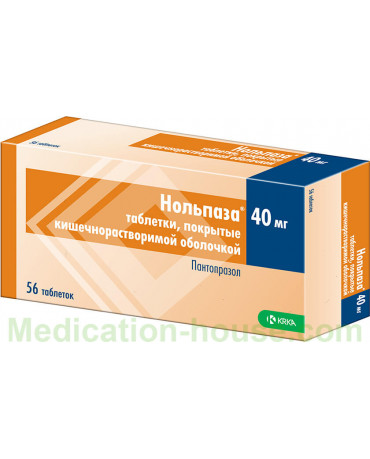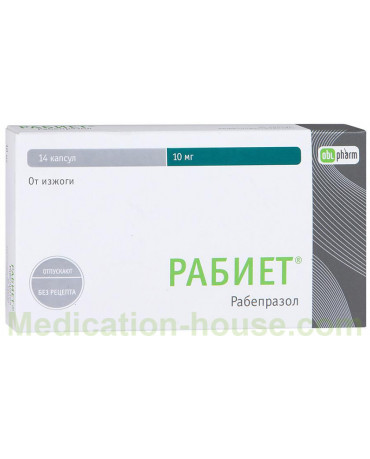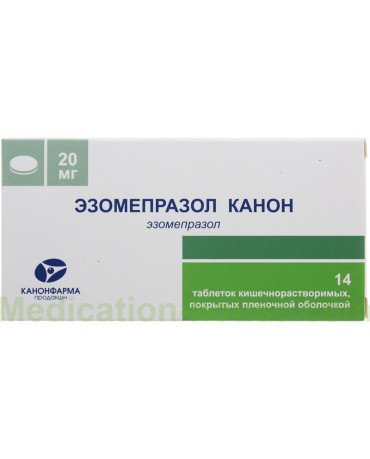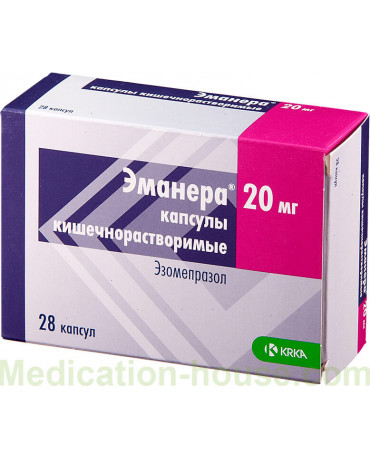Nexium instruction
You can buy Nexium here
Nexium is a drug that reduces the secretion of hydrochloric acid in the stomach.
Release form and composition
Nexium is available in:
Coated tablets: biconvex, oblong, at break - white with yellow impregnations; 20 mg each — light pink, with an engraving of “20 mG” on one side, on the other - “A / EN” in the form of a fraction; 40 mg each - pink, engraved with “40 mG” on one side, on the other - “A / EI” in the form of a fraction (in blisters of 7 pcs., 1, 2 or 4 blisters in a cardboard bundle);
The composition of 1 tablet includes:
Active substance: esomeprazole - 20 or 40 mg (in the form of magnesium esomeprazole trihydrate - 22.3 or 44.5 mg);
Auxiliary components (20/40 mg, respectively): glyceryl monostearate 40-55 - 1.7 / 2.3 mg, hyprolose - 8.1 / 11 mg, hypromellose - 17/26 mg, dye iron oxide red (E172) - 0 , 06 / 0.45 mg, dye iron oxide yellow (E172) - 0.02 / 0 mg, microcrystalline cellulose - 273/389 mg, magnesium stearate - 1.2 / 1.7 mg, copolymer of ethacrylic and methacrylic acids (1 : 1) - 35/46 mg, paraffin - 0.2 / 0.3 mg, polysorbate 80 - 0.62 / 1.1 mg, macrogol - 3 / 4.3 mg, crospovidone - 5.7 / 8.1 mg, sodium stearyl fumarate - 0.57 / 0.81 mg, sucrose spherical granules (sugar, spherical granules 0.25-0.355 mm in size) - 28/30 mg, titanium dioxide (E171) - 2.9 / 3.8 mg, talc - 14/20 mg, triethyl citrate - 10/14 mg.
Pharmacodynamics
Esomeprazole is the S-isomer of omeprazole and reduces the production of hydrochloric acid in the stomach by specifically inhibiting the proton pump in the parietal cells of the walls of the stomach. The R and S isomers of omeprazole have similar pharmacodynamic activity.
Esomeprazole is a weak base, transforming into an active form in an environment with increased acidity of the secretory tubules of parietal cells localized in the gastric mucosa. The substance also inhibits the proton pump, the enzyme H + / K + -ATPase. At the same time, both stimulated and basal secretion of hydrochloric acid is inhibited.
Esomeprazole begins to act within 1 hour after oral administration of 20 or 40 mg of Nexium. With daily use of the drug in a dose of 20 mg for 5 days 1 time per day, the maximum content of hydrochloric acid after stimulation with pentagastrin decreases on average by 90% (when determining the acid concentration 6-7 hours after taking Nexium on the 5th day of treatment).
In patients with gastroesophageal reflux disease (GERD), accompanied by severe clinical symptoms, after 5 days of daily oral administration of esomeprazole at a dose of 20 or 40 mg, the intragastric pH remained more than 4 for about 13 and 17 hours, respectively, from 24 hours. Against the background of the use of esomeprazole in a daily dose of 20 mg, the intragastric pH remained stable above 4 for at least 16, 12 and 8 hours in 24%, 54% and 76% of patients, respectively. In the case of a dose of 40 mg, this ratio is 56%, 92% and 97%.
With intravenous administration of esomeprazole at a dose of 80 mg for 30 minutes, followed by prolonged intravenous infusion of the drug at a dose of 8 mg / h for 23.5 hours, the pH of the stomach on average remained above 4 for 21 hours and above 6 for 11- 13 hours.
The level of esomeprazole in plasma correlates with the intensity of inhibition of hydrochloric acid synthesis (the AUC indicator (the area under the concentration-time curve) is used to determine the concentration.
When taking Nexium at a dose of 40 mg in 78% of patients, healing of reflux esophagitis is observed after 4 weeks of treatment and in 93% after 8 weeks of treatment. Taking the drug in a dosage of 20 mg 2 times a day in combination with carefully selected antibiotics for 1 week determines the successful eradication of Helicobacter pylori in about 90% of patients. Patients with uncomplicated peptic ulcer after completing a week-long eradication course do not need subsequent monotherapy with drugs that reduce the secretion of the gastric glands to eliminate symptoms and effectively heal the ulcer.
With the help of Nexium treatment, great success was achieved in stopping bleeding from a peptic ulcer diagnosed during endoscopic examination.
In 93.3% of patients aged 1–11 years, healing of erosive esophagitis was observed after 8 weeks of treatment with Nexium, which was confirmed by endoscopic studies. For patients with a body weight of less than 20 kg, the drug was prescribed in a daily dose of 5 and 10 mg, and for patients with a body weight of more than 20 kg - in a daily dose of 10 mg or 20 mg.
During therapy with drugs that suppress the secretion of gastric glands, the plasma gastrin content increases due to a decrease in the production of hydrochloric acid. Due to the inhibition of the synthesis of hydrochloric acid, the concentration of chromogranin A (CgA) increases. This phenomenon can affect the results of examinations to identify neuroendocrine tumors. To prevent this, treatment with proton pump inhibitors should be discontinued 5-14 days before the study of the content of CgA. If after a given period of time the concentration of the substance exceeds normal values, it is recommended that the tests be repeated.
In children and adult patients who have been treated with esomeprazole for a long time, there is an increase in the number of enterochromaffin-like cells, probably due to an increase in the concentration of gastrin in the plasma. The clinical significance of this phenomenon is minimal.
In patients who take drugs that inhibit the secretion of gastric glands for a long period of time, glandular cysts form in the stomach more often. This is due to physiological changes due to marked inhibition of hydrochloric acid production. Cysts are benign and prone to regression.
The use of Nexium may be accompanied by the growth of the microbial flora, which is normally present in the digestive tract, and a slight increase in the risk of developing infectious diseases of the digestive tract, the causative agents of which are Campylobacter spp., Salmonella spp. and probably in patients in the hospital Clostridium difficile.
Nexium has better efficacy compared to ranitidine in the healing of gastric ulcers in patients taking non-steroidal anti-inflammatory drugs (NSAIDs), including selective cyclooxygenase-2 inhibitors (COX-2). In patients taking NSAIDs (more than 60 years of age and / or a history of peptic ulcer), including selective COX-2 inhibitors, the drug has been shown to be highly effective as a prophylactic to prevent stomach and duodenal ulcers.
Pharmacokinetics
Esomeprazole is not stable in an acidic environment, therefore, for oral administration, enteric coated pellets are often used. Under in vivo conditions, only a small fraction of the active component of Nexium is converted to the R-isomer. Esomeprazole is absorbed quickly enough: its maximum plasma level is recorded 1-2 hours after administration. The absolute bioavailability of a substance after a single dose of Nexium at a dose of 40 mg is 64% and increases to 89% with a daily dose of 1 time per day. When taking esomeprazole in a single dose of 20 mg, these indicators are about 50% and 68%, respectively. In healthy people, the distribution volume at equilibrium concentration is approximately 0.22 l / kg body weight. The degree of binding of esomeprazole to plasma proteins is approximately 97%.
With repeated intravenous administration of Nexium at a dose of 40 mg, its maximum plasma content reaches an average of about 13.6 μmol / L.
Eating inhibits and reduces the absorption of esomeprazole in the stomach, but this does not affect the effectiveness of inhibition of hydrochloric acid synthesis. The compound is metabolized with the participation of the cytochrome P450 system. The metabolism of the main part is carried out through a special polymorphic isoenzyme CYP2C19, and the final products are desmethylated and hydroxylated metabolites of esomeprazole. In the metabolic processes of the remaining part of esomeprazole, the CYP3A4 isoenzyme takes part, which is responsible for the formation of the sulfonic active substance Nexium, the main metabolite found in plasma.
The total clearance is approximately 17 l / h after a single dose of Nexium and 9 l / h after multiple doses. The elimination half-life is 1.3 hours with systematic administration at least 1 time per day. The area under the concentration-time curve (AUC) increases with repeated use of the drug. In this case, the dose-dependent increase in AUC is non-linear, which is caused by inhibition of metabolism due to the effect of the "first passage" through the liver, as well as a decrease in systemic clearance, probably provoked by inhibition of the CYP2C19 isoenzyme by the active substance Nexium and / or its sulfonic derivative. With daily intake, once a day, esomeprazole is almost 100% excreted from blood plasma in the intervals between its ingestion and is not subject to cumulation.
With the intravenous administration of Nexium at doses of 120 mg, 80 mg and 40 mg for 30 minutes, followed by administration at a dose of 8 mg / h or 4 mg / h for 23.5 hours, the linear dependence of AUC on the administered dose is determined.
The main metabolites of esomeprazole do not affect the production of hydrochloric acid. When taken orally, up to 80% of the dose is excreted through the kidneys, the rest through the intestines. In urine, less than 1% of esomeprazole is present unchanged.
In patients of advanced age (71–80 years), the metabolism of the drug does not significantly change. After a single dose of 40 mg esomeprazole, the average AUC in women is 30% higher than that in men. With daily use of Nexium once a day, differences in the pharmacokinetics of women and men are not recorded.
In patients with mild to moderate hepatic insufficiency, metabolic disorders of esomeprazole are sometimes observed. In patients with severe hepatic insufficiency, the metabolic rate decreases, which leads to a 2-fold increase in AUC. In such patients, it is not recommended to exceed the maximum daily dose of 20 mg. When taking Nexium 1 time per day, esomeprazole and its main metabolites are not cumulated in the body.
The pharmacokinetics of the drug in patients with renal failure is poorly understood. Since it is not esomeprazole itself that is excreted in the urine, but its metabolites, it can be assumed that in such patients the metabolism of the active substance Nexium does not change.
In children aged 12–18 years after repeated intake of 20 and 40 mg of esomeprazole, the AUC and the time to reach the maximum concentration of the substance in blood plasma were similar to these parameters in adults. Repeated administration of 10 mg of the drug by children aged 1–11 years did not lead to a change in AUC compared with adolescents and adults who took this dose. Repeated intake of 20 mg of esomeprazole in patients of the same age category causes an increase in AUC of 6-11 times compared with adolescents and adults who took this dose.
Indications for use
Granules and pellets for oral suspension, tablets
Treatment of erosive reflux esophagitis;
Long-term supportive treatment in patients after healing of erosive reflux esophagitis (in order to prevent relapse);
Symptomatic treatment of gastroesophageal reflux disease;
Therapy of duodenal ulcer associated with Helicobacter pylori (Helicobacter pylori);
Prevention of relapse associated with Helicobacter pylori peptic ulcer;
Prolonged acid-suppressing treatment after bleeding from a peptic ulcer (after intravenous administration of drugs that reduce the secretion of the gastric glands to prevent relapse);
Healing of gastric ulcers associated with the use of non-steroidal anti-inflammatory drugs;
Prevention of gastric and duodenal ulcers associated with the use of non-steroidal anti-inflammatory drugs in patients at risk;
Zollinger-Ellison syndrome or other conditions that are characterized by pathological hypersecretion (including idiopathic hypersecretion).
Contraindications
Glucose-galactose malabsorption, hereditary fructose intolerance, sucrose-isomaltase deficiency (tablets, granules and pellets);
Concomitant use with atazanavir and nelfinavir;
Hypersensitivity to the components of the drug, as well as to substituted benzimidazoles.
According to the instructions, Nexium should be used with caution in patients with severe renal failure.
Depending on the dosage form, Nexium is contraindicated in children in the following cases:
Tablets: age up to 12 years - all indications; age 12-18 years - all indications, except gastroesophageal reflux disease;
Pregnant women can be prescribed Nexium only after assessing the benefit / risk ratio for the health of the mother and the fetus. During lactation during the treatment period, breastfeeding is recommended to be interrupted.
Instructions for use of Nexium: method and dosage
Nexium in the form of tablets should be swallowed whole (without chewing or crushing), washed down with liquid. If swallowing is difficult, the tablet can be dissolved in 1/2 cup of still water. Drink the resulting suspension of microgranules for 30 minutes, after which you need to once again fill a glass with 100 ml of water, stir the rest of the drug and drink.
The following dosage regimen is recommended:
Treatment of erosive reflux esophagitis (children 1-11 years old with a body weight of 10 kg, Nexium in the form of granules and pellets): a single dose for children weighing 10-20 kg is 10 mg, more than 20 kg - 10-20 mg. Multiplicity of admission - 1 time per day, duration of therapy - 8 weeks;
Symptomatic treatment of gastroesophageal reflux disease (children 1-11 years old with a body weight of 10 kg, Nexium in the form of granules and pellets): 1 time per day for 10 mg for up to 8 weeks;
Treatment of erosive reflux esophagitis (adults and children from 12 years old): 1 time per day, 40 mg for a month. An additional four-week course of treatment is recommended to be carried out while maintaining the symptoms of the disease or if, after the first course, the cure of esophagitis has not occurred;
Long-term maintenance therapy to prevent relapse (adults and children from 12 years old): 20 mg once a day;
Symptomatic therapy of gastroesophageal reflux disease without esophagitis (adults and children from 12 years old): 20 mg once a day. If after a month of therapy the symptoms do not go away, an additional examination is necessary. After improvement, it is possible to switch to the Nexium regimen “as needed”, i.e. the drug is taken when symptoms occur before they are removed in a daily dose of 20 mg in 1 dose. For patients taking non-steroidal anti-inflammatory drugs, and patients at risk of developing stomach ulcers or duodenal ulcers, therapy in the “as needed” mode is not recommended;
Peptic ulcer of the stomach and duodenum (simultaneously with other drugs) for eradication of Helicobacter pylori, as well as treatment of duodenal ulcer associated with Helicobacter pylori, and prevention of relapse of peptic ulcer associated with this bacterium in patients with peptic ulcer (adults): 2 times 20 mg of Nexium, 500 mg of clarithromycin and 1000 mg of amoxicillin per day. Therapy is carried out for 7 days;
Long-term acid-suppressing therapy in patients undergoing bleeding from a peptic ulcer after intravenous administration of antisecretory drugs for the prevention of relapse (adults): 1 time per day, 40 mg for 30 days (after the end of intravenous therapy with antisecretory drugs);
Healing of gastric ulcers associated with prolonged use of non-steroidal anti-inflammatory drugs (adults): 1 time per day, 20 or 40 mg, course duration - 1-2 months;
Prevention of gastric and duodenal ulcers associated with the use of non-steroidal anti-inflammatory drugs: 1 time per day, 20 or 40 mg;
Conditions characterized by pathological hypersecretion, including Zollinger-Ellison syndrome and idiopathic hypersecretion: initial dose - 2 mg 40 times a day. In the future, the dose is selected individually, the duration of the course is determined by the clinical picture of the disease.
When Nexium is prescribed in all dosage forms to patients with impaired renal function, dose adjustment is not required. Use the drug with caution in patients with renal failure.
Due to limited clinical experience, Nexium should be prescribed with caution in patients with severe renal failure. The maximum daily dose for severe liver failure in adults and children from 12 years old should be no more than 20 mg, in children 1-11 years old - no more than 10 mg.
Elderly patients should not adjust the dosage regimen.
Side effects
Nervous system: often - headache; infrequently - paresthesia, dizziness, drowsiness; rarely - taste impairment;
Musculoskeletal system: rarely - myalgia, arthralgia; very rarely - muscle weakness;
Hematopoietic system: rarely - leukopenia, thrombocytopenia; very rarely - pancytopenia, agranulocytosis;
Urinary system: very rarely - interstitial nephritis;
Respiratory system: rarely - bronchospasm;
Gastrointestinal tract: often - constipation, abdominal pain, diarrhea, flatulence, vomiting / nausea; infrequently - dry mouth; rarely - candidiasis of the gastrointestinal tract, stomatitis; very rarely - microscopic colitis confirmed by histological studies;
Skin and subcutaneous tissue: often - reactions at the injection site (with intravenous administration); infrequently - dermatitis, rash, itching, urticaria; rarely - photosensitivity, alopecia; very rarely - toxic epidermal necrolysis, Stevens-Johnson syndrome, erythema multiforme;
Mammary glands and reproductive system: very rarely - gynecomastia;
Liver and biliary tract: infrequently - increased activity of liver enzymes; rarely - hepatitis (accompanied by jaundice or without it); very rarely - liver failure, encephalopathy in patients with liver disease;
Organ of vision: rarely - blurred vision;
Mental disorders: infrequently - insomnia; rarely - arousal, depression, confusion; very rarely - aggressive behavior, hallucinations;
Metabolism: rarely - hyponatremia; very rarely - hypomagnesemia, hypocalcemia (associated with severe hypomagnesemia), hypokalemia (caused by hypomagnesemia);
Allergic reactions: rarely - hypersensitivity reactions (in the form of fever, angioedema, anaphylactic reactions / anaphylactic shock);
Other: infrequently - peripheral edema; rarely sweating, malaise.
With the intravenous administration of Nexium to critically ill patients, especially with the introduction of high doses, the development of irreversible visual impairment is possible (a causal relationship with the therapy has not been established).
Overdose
To date, there are references to isolated cases of intentional overdose. The ingestion of esomeprazole at a dose of 280 mg was accompanied by unpleasant symptoms from the gastrointestinal tract and general weakness. A single dose of 80 mg of the drug did not lead to any negative consequences.
The antidote of esomeprazole is currently not found. Dialysis is not very effective due to the high binding of the active component of Nexium to plasma proteins. If necessary, symptomatic and general supportive therapy is prescribed.
Special instructions
In the event of any alarming signs (in the form of significant sudden loss of body weight, repeated vomiting, dysphagia, vomiting with an admixture of blood), as well as in the presence of a stomach ulcer (or if it is suspected), it is necessary to exclude the presence of malignant neoplasms, since the use of Nexium can lead to smoothing out symptoms, which will delay the diagnosis.
During long-term treatment (especially longer than a year), patients should undergo regular medical supervision.
In cases where the drug is used “as needed”, the doctor should be informed about the appearance of atypical symptoms.
During therapy to eradicate Helicobacter pylori, the possibility of drug interaction of all drugs used must be considered.
If there is a high risk of developing fractures or osteoporosis, patients should be under appropriate clinical supervision.
During therapy, care should be taken when driving, which is associated with the likelihood of developing side effects such as dizziness, drowsiness, and blurred vision.
Drug interaction
With the simultaneous use of Nexium with certain drugs, the following effects may occur:
Ketoconazole, itraconazole, erlotinib: decrease in their absorption;
Digoxin: increase its absorption;
Antiretroviral drugs (atazanavir, nelfinavir): a decrease in their concentration in serum (a combination is not recommended);
Saquinavir: an increase in its concentration in serum;
Citalopram, diazepam, imipramine, phenytoin, clomipramine and other drugs in the metabolism of which isoenzyme CYP2C19 takes part: increase in their concentration in plasma;
Phenytoin: increase in its residual concentration in patients with epilepsy;
Tacrolimus, methotrexate: increase in its concentration in blood serum;
Hypericum perforatum, rifampicin: a decrease in the concentration of esomeprazole in blood plasma.
Nexium Reviews
According to reviews, Nexium is an effective drug - a proton pump inhibitor that allows you to normalize acidity in the digestive tract. It has a pronounced therapeutic effect. Patients respond well about him, noting that the improvement came fairly quickly. Side effects are extremely rare, but some patients do not like the high cost of Nexium.
Terms of sell
You don't need a prescription to buy Nexium.






